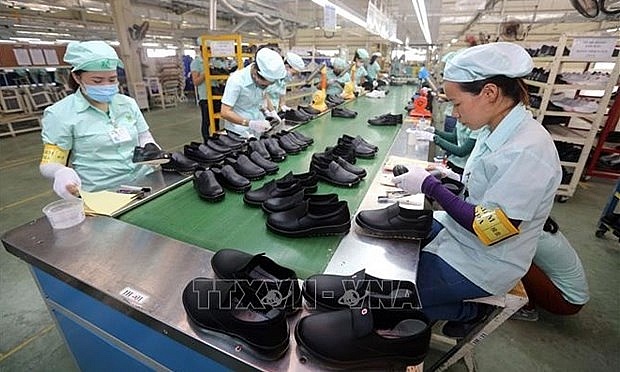Brands reorganising supply chain process and resilience
 |
| Illustrative image (Source: VNA) |
American fashion retailer Gap has decided to accelerate sourcing its supplies from locations in the proximity of the United States, such as Mexico and Central America, following port congestion and closures of factories in Vietnam that pushed up transportation costs, CEO Sonia Syngal said at the beginning of March, as reported by Retail Dive.
“We are working on de-risking our supply chain by rebalancing our sourcing to rely less on single countries of origin and building deeper relationships with near-shore vendors,” said Syngal.
This decision came after continuous delays of up to 10 weeks for seasonal products because of pandemic-induced factory closures in Vietnam.
Last September, Nike also reported supply chain problems in connection with its sneaker factories in Vietnam, which would hamper its sales.
However, unlike Gap, the well-known footwear brand managed to navigate the supply-chain snarls and subsequently grew its sales again, as the company reported at the start of March.
Nike also said that all of its Asian suppliers are now back to full production – which was also shared by representatives of Nike Vietnam Co., Ltd at a meeting between officials of the Ministry of Industry and Trade and other American businesses in Vietnam on March 8.
Le Duy Hiep, chairman of the Vietnam Logistics Association, said that the pandemic led to an imbalance between supply and demand for containerised goods, with a large backlog in North American and European countries but shortages in China and other Asian markets pushing freight rates to an unprecedented height – up to 10 times that of 2020.
“We should consider restructuring our supply chains now that labour supply problems in are slowly eased, shortages of warehouse space are resolved, and ocean freight looks likely to gradually recover as well,” Hiep said. “Shipping may return to focusing on garments as planned, and air transport will depend heavily on electronic products.”
The utilisation of trade agreements and completely overhauling the trading model could help create supply chains both domestically and internationally, insiders say. However, supply chains here has not kept up with the import demand and the traffic network is overloaded, which may slow down economic recovery.
International trade in 2021 was overshadowed by the successive shocks in the shipping industry, which carries more than 90 per cent of global goods.
As a consequence, some foreign companies that utilise Vietnam for their production bases have been reconsidering their supply chains as well as sourcing locations.
Supply chain management in Vietnam focuses not only on cost management but also on the supply chains’ resilience and risk management to make sure that these are quickly adaptable to any unforeseen events.
Julien Brun, managing partner at CEL Consulting, said, “Unfortunately, there is no shortcut. It will take years for companies to move from just-in-time to just-in-case. Also, no-one will be able to prepare for every shock. Large global shocks are unpredictable, and there is no way to be bulletproof for all of it.”
Brun said that resilience means establishing safety margins and keeping some buffer to stay at float when the winds blow. Cost factors like redundant suppliers, inventory, and unused capacity, as well as a tradeoff between preparing for potential risks and a company’s actual profitability, all matter in the long run.
“Every company will set a reasonable balance based on what profits can be omitted in the short or long term. This tradeoff is not new, it’s just exacerbated with recent happenings,” Brun said.
The conflict in Ukraine also shows that one crisis can be followed by another one.
“This particular one is also having a big impact on the profitability and cash flow of companies in Vietnam,” Brun said. “So, while the storm is carrying on, adaptability is what matters now, and resilience will be a resulting factor of it, more than a conscious initiative.”
What the stars mean:
★ Poor ★ ★ Promising ★★★ Good ★★★★ Very good ★★★★★ Exceptional
Related Contents
Latest News
More News
- Global partnerships key to Vietnam’s IFC development (December 26, 2025 | 16:18)
- Vingroup pulls out of bid to invest in North-South high-speed railway (December 26, 2025 | 11:42)
- Strengthening supply chains through trade promotions and customs reform (December 24, 2025 | 14:00)
- PM orders investment model for North–South high-speed rail (December 22, 2025 | 17:43)
- LS Eco Energy to invest in Vietnam rare earth sector (December 22, 2025 | 17:31)
- Government moves to establish International Financial Centre (December 21, 2025 | 21:00)
- Vietnam's IFC to target global investment flows (December 21, 2025 | 18:00)
- Two national hospitals expand capacity with new facilities (December 20, 2025 | 09:00)
- Ha Tinh breaks ground on major Vingroup industrial and energy projects (December 19, 2025 | 18:24)
- EVN launches major power infrastructure projects nationwide (December 19, 2025 | 18:17)

 Tag:
Tag:





















 Mobile Version
Mobile Version